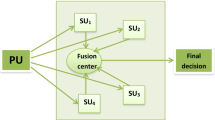Abstract
Heterogeneous network can improve the reliability and data rate of communication services especially at cell edges and remote areas. Due to the spectrum scarcity, the large number of small cells may reuse the same frequency bands as the adjacent cells or primary systems. Cognitive features facilitate the secondary network to sense and utilize the spectrum holes. In this paper, compressed spectrum sensing is proposed for wideband signals to reduce the cost and implementation complexity of wideband analog to digital converter for heterogeneous network. This mechanism employs wavelet based energy detection with adaptive threshoding in decision making procedure. Linear and nonlinear recovery programs are addressed to be compared for compressed spectrum sensing. A paradigm of long term evolution advanced system is simulated to verify the robustness of the proposed method for heterogeneous network over multipath fading channel. The power spectrum density of reconstructed signals are compared and analyzed for various compressed sensing algorithms. The results of Log Barrier method are promising in terms of probability of detection and controlled probability of false alarm around the standard values with compression ratios higher than 20% of Nyquist rate.












Similar content being viewed by others
References
Dong, Y., Chen, Z., Fan, P., & Letaief, K.B. (2014). Mobility-aware interference model for 5G heterogeneous networks. In Computer science and information technology (pp. 1–12).
Lei, W., Hai, W., Yinghui, Y., & Fei, Z. (2010). Heterogeneous network in LTE-Advanced system. In IEEE international conference on communication systems (ICCS) (pp. 156–160).
Petelin, O., Adve, R., & Rogers, E. S. (2013). Distributed resource allocation in femtocell networks. In 13th Canadian workshop on information theory (CWIT) (pp. 102–107).
Deruyck, M., Joseph, W., Lannoo, B., Colle, D., & Martens, L. (2013). Designing energy-efficient wireless access networks: LTE and LTE-advanced. IEEE Internet Computing, 17, 39–45.
Feki, A., Capdevielle, V., Roullet, L., & Sanchez, A. G. (2013). Handover aware interference management in LTE small cells networks. In 11th International symposium on modeling and optimization in mobile, ad hoc and wireless networks (WiOpt) (pp. 49–53).
Zhang, Y.-P., Feng, S., Zhang, P., & Xia, L. (2013). Inter-cell interference management in LTE-a small-cell networks. In IEEE vehicular technology conference (VTC) (pp. 1–6).
Nam, W., Bai, D., Lee, J., & Kang, I. (2014). Advanced interference management for 5G cellular networks. IEEE Communications Magazine, 52(5), 52–60.
Daeinabi, A., Sandrasegaran, K., & Zhu, X. (2013). An intercell interference coordination scheme in LTE downlink networks based on user priority and fuzzy logic system. International Journal of Wireless and Mobile Networks (IJWMN), 5(4), 49–64.
Herranz, C., Osa, V., Monserrat, J.F., Calabuig, D., Cardona, N., & Gelabert, X. (2012). Cognitive radio enabling opportunistic spectrum access in LTE-advanced femtocells. In IEEE international conference on communications (ICC) (pp. 5593–5597).
Zhang, L., Yang, L., & Yang, T. (2010). Cognitive interference management for LTE-a femtocells with distributed carrier selection. In IEEE vehicular technology conference (VTC) (pp. 1–5).
Almeida, E., Cavalcante, A.M., Paiva, R.C.D., & Chaves, F.S. (2013). Enabling LTE/WiFi coexistence by LTE blank sub-frame allocation. In IEEE international conference on communications (ICC) (pp. 5083–5088).
Mavromoustakis, C. X., Mastorakis, G., Bourdena, A., & Pallis, E. (2014). Joint energy and delay-aware scheme for 5G mobile cognitive radio networks. In IEEE global communications conference (GLOBECOM) (pp. 2624–2630).
Molisch, A. F., Greenstein, L. J., & Shafi, M. (2009). Propagation issues for cognitive radio. Proceedings of the IEEE, 97(5), 787–804.
Yang, L., Yang, L., Zhu, H., & Ren, G. (2015). Time-varying Doppler frequency offset estimation method for LTE-TDD uplink with multi-user in HST. Wireless Personal Communications, 82(2), 1127–1146.
Rebeiz, E., Urriza, P., & Cabric, D. (2013). Optimizing wideband cyclostationary spectrum sensing under receiver impairments. IEEE Transactions on Signal Processing, 61(15), 3931–3943.
Karakaya, B., Arslan, H., & Cirpan, H.A. (2008). Channel estimation for LTE uplink in high Doppler spread. In IEEE wireless communications and networking conference (WCNC) (pp. 1126–1130).
Zeng, Y., Liang, Y.-C., Hoang, A. T., & Zhang, R. (2010). A review on spectrum sensing for cognitive radio: Challenges and solutions. EURASIP Journal on Advances in Signal Processing, 2010, 2.
Quan, Z., Cui, S., Sayed, A. H., & Poor, H. V. (2008). Wideband spectrum sensing in cognitive radio networks. In International conference on communications (ICC) (pp. 901–906).
Yu, Z., & Hoyos, S. (2009). Compressive spectrum sensing front-ends for cognitive radios. In IEEE international conference on systems, man and cybernetics (SMC) (pp. 1899–1904).
Cabric, D., Mishra, S. M., & Brodersen, R. W. (2004). Implementation issues in spectrum sensing for cognitive radios. IEEE Conference on Signals, Systems and Computers, 1, 772–776.
Boroujeny, F. (2008). Filter bank spectrum sensing for cognitive radios. IEEE Transactions on Signal Processing, 56(5), 1801–1811.
Li, J., & Zhao, Y. (2012). Radio environment map-based cognitive Doppler spread compensation algorithms for high-speed rail broadband mobile communications. EURASIP Journal on Wireless Communications and Networking, 263, 1–18.
Rateb, A. M., & Yusof, S. K. S. (2015). Recovery error bounds on compressed sensing of noisy signals. International Journal of Communication Systems, 28, 546–559.
Cand‘es, E., Romberg, J., & Tao, T. (2006). Stable signal recovery from incomplete and inaccurate measurements. Communications on Pure and Applied Mathematics, Wiley, 59(8), 1207–1223.
Boyd, S., & Vandenberghe, L. (2004). Convex optimization. Cambridge: Cambridge University Press.
Cand‘es, E., & Tao, T. (2005). The Dantzig selector: Statistical estimation when p is much smaller than n. Manuscript, pp. 1–37.
Wright, S. J. (1997). Primal-dual interior-point methods. Philadelphia: SIAM Publications.
Hosseini, H., Fisal, N. B., & Yusof, S. K. S. (2011). Enhanced FCME thresholding for wavelet-based cognitive UWB over fading channels. Journal of Electronics and Telecommunications Research Institute (ETRI), South Korea, 33(6), 961–964.
Cand‘es, E., & Romberg, J. (2005). L1-magic: Recovery of sparse signals via convex programming, pp. 1–19.
Author information
Authors and Affiliations
Corresponding author
Rights and permissions
About this article
Cite this article
Hosseini, H., Anpalagan, A. & Raahemifar, K. Compressed Spectrum Sensing for Wavelet Based Cognitive Heterogeneous Network over Multipath Fading. Wireless Pers Commun 96, 3947–3964 (2017). https://doi.org/10.1007/s11277-017-4360-7
Published:
Issue Date:
DOI: https://doi.org/10.1007/s11277-017-4360-7




